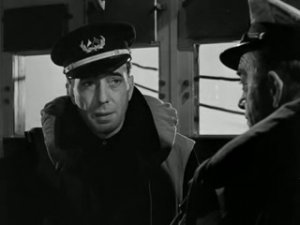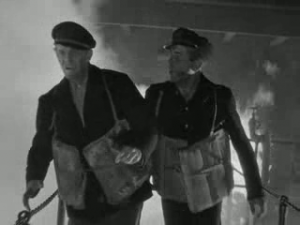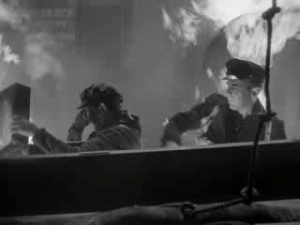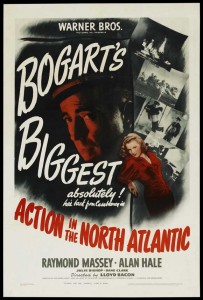Warner Bros. thunderous story of the men of the merchant marine!
Many films highlight the efforts of the armed services, but few focus on the service upon which centers 1943’s Action in the North Atlantic. Rather, Action in the North Atlantic concentrates on perhaps the unarmed service, that of the merchant marine.
The resulting film is a pure propaganda piece with all the required moralistic speeches and stereotypical characterizations so as to touch all facets of American culture of the time. Taken for what it was intended to be, a morale boost for the home front and perhaps a recruitment tool as well, it is not only well done but also extremely effective.
Perhaps too this helped moviegoers of the time turn out or black out their lights after dark. This was made during the last period of heavy losses in the Battle of the Atlantic, most of which were happening along the American coast, where lone ships sailed back-lit by fully illuminated American cities. They made such easy targets that the Germans termed this “The Happy Time.” Towards the middle of 1943 this faded as America adopted many of the guidelines Britain had implemented in 1939-1940.
 Taken as a picture overall, without the context of when it was made, it is a tight actioner, but no great classic. The lengthy (and sometimes slightly leftist) speeches scattered throughout detract from the reality and gravity of the drama and diminish the overall story. Ironically, these same things are exactly what makes Action in the North Atlantic an effective propaganda piece.
Taken as a picture overall, without the context of when it was made, it is a tight actioner, but no great classic. The lengthy (and sometimes slightly leftist) speeches scattered throughout detract from the reality and gravity of the drama and diminish the overall story. Ironically, these same things are exactly what makes Action in the North Atlantic an effective propaganda piece.
The plot is as expected, highlighting the epic struggles of the merchant marine against the sea and the Germans. Humphrey Bogart and Raymond Massey star, the latter in a rare “good guy” role, as officers on a freighter. They are joined by many of the stock Warner crew of supporting actors of the time, including Alan Hale, who add some comic relief.
The picture opens with Bogart and Massey’s freighter being torpedoed and sinking. They are ultimately rescued and have a shore time at home- which gives us and viewers of the time the chance to live vicariously though the on-screen action. Remember many were going through these same challenges of family members abroad with little or no communication. Humphrey Bogart and Raymond Massey ultimately take another ship on a run to Murmansk, but while in convoy are set upon by a German wolfpack.
 What does make Action in the North Atlantic worth the price of admission are the action sequences, which are beyond spectacular. Especially note the dramatic footage during the sinking of Bogart’s original ship, as actors dance and dart around the flames. Humphrey Bogart and Raymond Massey ultimately did their own stunts for the film, so when you see their characters running for their lives, you’re watching the real McCoy. And there is a LOT of fire. Real fire- no CGI.
What does make Action in the North Atlantic worth the price of admission are the action sequences, which are beyond spectacular. Especially note the dramatic footage during the sinking of Bogart’s original ship, as actors dance and dart around the flames. Humphrey Bogart and Raymond Massey ultimately did their own stunts for the film, so when you see their characters running for their lives, you’re watching the real McCoy. And there is a LOT of fire. Real fire- no CGI.
Beyond this the technical challenges of actually filming such a film in 1943 era America were daunting. The production was prohibited from actually filming at sea because of wartime restrictions so all of the footage was filmed on soundstages. Some actual combat footage was spliced in appropriately and can be easily identified today be the varying texture and quality of the footage.
 The mock Liberty ships created on set were so large that technology of the day wasn’t able to rock them to simulate the motion of a ship at sea, so as an alternative approach the camera itself was rocked to compensate. Quite creative and unnoticeable.
The mock Liberty ships created on set were so large that technology of the day wasn’t able to rock them to simulate the motion of a ship at sea, so as an alternative approach the camera itself was rocked to compensate. Quite creative and unnoticeable.
Action in the North Atlantic is easy to locate if you’d like a viewing, but it has to be watched in the context of the time in which it was made. The sometimes heavy-handed propaganda seems overwhelming today but was needed then. And although the cast really makes average performances, they do convey strong vignettes of the challenges these seamen faced.
Well worth a look. That ship sinking alone is worth the price of admission.
